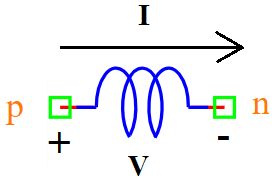Inductor with initial current
Symbol
Information

An inductor is a passive electrical component that stores energy in a magnetic field and resists changes in current. This model implements an inductor with an initial current (Ic), meaning it starts with a predefined current when the simulation begins.
The voltage-current relationship of an ideal inductor is given by:
Where: - \(V\) is the voltage across the inductor - \(I\) is the current through the inductor - \(L\) is the inductance (in Henrys) - \(I_c\) is the initial current
Ports
p, n → Inductor terminals (voltage across & current through)
Symbol description
Field |
Value |
|---|---|
Symbol.name |
InductorIc |
Symbol.file |
InductorIc.sym |
Symbol.directory |
Basic |
Symbol.referance |
|
Model.name |
|
Model.file |
InductorIc.py |
Model
This model represents an inductor with an initial current. The voltage across the inductor is proportional to the rate of change of current.
Attributes:
V (signal): Output voltage across the inductor.
I (signal): Input current through the inductor.
L (param): Inductance value in Henrys (default: 1.0e-3 H).
Ic (param): Initial current in Amperes (default: 0 A).
Methods:
analog(): Defines the voltage-current relationship using the differential equation.
from pyams.lib import signal, model, param
from pyams.lib import voltage, current
from pyams.lib import ddt
class InductorIc(model):
"""
Inductor model with initial current.
"""
def __init__(self, p, n):
# Signal declarations
self.V = signal('out', voltage, p, n)
self.I = signal('in', current, p, n)
# Parameter declarations
self.L = param(1.0e-3, 'H', 'Inductor value')
self.Ic = param(0, 'A', 'Initial charge')
def analog(self):
"""Defines the inductor's voltage-current relationship with initial current."""
self.V += self.L * ddt(self.I, self.Ic)
Command syntax
To use this InductorIc model in a PyAMS simulation:
# Import the model
from pyams.models import InductorIc
# Define the inductor
# L1: instance name
# p, n: Inductor terminals
L1 = InductorIc(p, n)